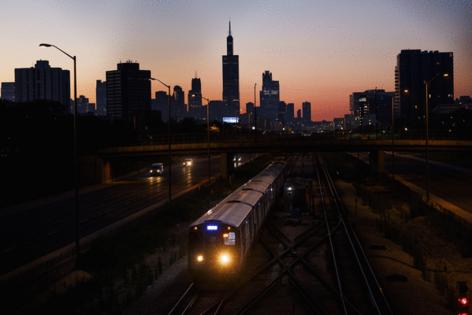Illinois lawmakers pass mass transit funding bill. Here's what that means for CTA, Metra and Pace riders
Published in News & Features
CHICAGO — For months, Illinois transit leaders warned of a doomsday scenario that would hobble the region’s mass transit systems.
Dozens of bus lines were on the chopping block, they warned, along with whole portions of the “L.” Thousands of workers faced the threat of layoffs. Transit advocates warned that service cuts would have wide-ranging consequences for the Chicago economy and the environment.
As of Friday morning, that scenario seems to be in the rearview mirror.
After multiple failed legislative proposals, state lawmakers finally got a transit funding deal across the finish line in the early morning hours on Friday. Gov. JB Pritzker said he intends to sign the measure into law.
In addition to raising around $1.5 billion, the deal will overhaul the Chicago region’s mass transit system by creating a new governing body to oversee the CTA, Metra and Pace called the Northern Illinois Transit Authority.
The deal includes various initiatives intended to bolster safety on the region’s transit systems. It appears to pump the brakes on planned fare increases next year.
Perhaps of most importance to riders, the deal will prevent planned service cuts and layoffs on the CTA next year, according to the agency itself.
“This legislation is the most transformative change to our public transit systems in the state of Illinois in five decades,” said state Sen. Ram Villivalam of Chicago, a Democrat who has helped lead transit reform and funding.
The legislative effort addresses what experts have termed the transit “fiscal cliff,” a financial crisis that loomed as the CTA, Metra and Pace started running out of aid they received from the federal government during the pandemic. At the same time, ridership numbers have simply not returned to 2019 levels, meaning agencies aren’t making as much of their revenue from fares as they used to.
The agencies were facing a structural budget deficit that would start next year and balloon to more than $800 million in 2027 and beyond.
The deal comes with enough dollars to address the budget deficit each year and provide even more funding on top of that, which the region’s transit agencies have said they’d use to make improvements in service.
Here’s what Chicago-area transit riders need to know.
Where is the money coming from?
The new bill funds mass transit without the broad taxes and fees that seemed to tank previous versions of the legislation.
The biggest chunks of money come from diverting funds that would typically be used for road construction projects to mass transit. That includes $860 million in sales tax revenue on motor fuel and $200 million from the interest earned on the state’s road fund that would now go to transit.
Another $400 million would come from authorizing an increase of 0.25 percentage points in the sales tax issued by the Regional Transportation Authority in Cook County and the collars.
To make up for the money diverted away from road work, the bill also includes a sharp 45-cent-per-toll increase on the Illinois Tollway.
Does this mean there won’t be any service cuts on the CTA next year?
There won’t be service cuts or layoffs on the CTA, according to interim agency president Nora Leerhsen.
“With these funds, we will expand our bus and rail service, invest in new technologies, and implement new strategies to support our riders and employees,” Leerhsen said in a statement Friday.
Before the legislation passed, Leerhsen said the agency was poised to make “the single-largest transit service cut in the modern history of the Chicago Transit Authority.” Cuts to bus and train service were expected to start next August.
But when the CTA prepared its 2026 budget, it came up with three plans: One austerity budget, one status quo budget and one best-case scenario budget assuming state lawmakers came up with around $1.5 billion for regional transit.
In that best-case scenario budget, the CTA outlined what it described as an “ambitious plan to take transit service to a level never seen in Chicago.” It’s not clear if the CTA plans to follow that budget directly to the letter, particularly because of uncertainty around planned fare increases.
In that plan, the CTA said it would run more frequent rail service, with a goal of achieving eight-minute-or-less headways on all train lines, all day, every day. The agency also said it would add more bus lines to its Frequent Network and would put resources toward eliminating the scourge of slow zones on train lines.
What about Metra and Pace?
Neither Metra nor Pace had planned to cut bus or train service next year, although both had warned that without more money, they’d have to do so in 2027 and beyond.
In a statement, Pace’s executive director, Melinda Metzger, said the agency would now be able to “deliver more service, increased frequency, expanded bus-on-shoulder operations, new bus rapid transit corridors, and innovative solutions to meet growing demand.”
Metra spokesperson Michael Gillis said the commuter rail agency “look(s) forward to working with lawmakers, our fellow transit agencies, and all stakeholders to meet the promise of this significant legislation and establish the world-class system that our constituents and riders need and deserve.”
How much will it cost to ride the CTA, Metra and Pace next year?
It’s not clear.
The CTA, Metra and Pace all planned to raise fares around 10 to 15% next year — whether or not lawmakers came up with more funding.
The RTA, which oversees all three agencies, had mandated they do so to help plug the looming budget shortfall. At the CTA, for example, a planned 25-cent-per-ride fare hike was expected to generate around $30 to $35 million in revenue.
The new legislation, however, prohibits any fare increases for the first year after its effective date. Because the bill takes effect in June, it does not appear it would explicitly prohibit the CTA, Metra and Pace from going through with their planned fare increases, which were planned to take effect Feb. 1.
But lawmakers said their intention was to stop the fare increases, which would be the first the agencies have taken in years.
Villivalam said that though the bill does not explicitly prohibit fare hikes before June 1 next year, legislators didn’t want the transit agencies to go through with them.
“I believe there is consensus from the Illinois General Assembly that fare increases should not be implemented until service is stabilized,” Villivalam said.
A spokesperson for state Rep. Eva-Dina Delgado, a Chicago Democrat who was one of the key architects of the legislation, also said the measure is intended to prevent fare hikes next year.
The RTA did not directly answer a question about the prohibition on fare increases.
In a statement, the agency said it was “continuing to review the bill and will share more in the days ahead, including how this impacts the 2026 budget process.”
What about transit reforms?
The bill will replace the RTA with a new entity called the Northern Illinois Transit Authority, or NITA, which is supposed to act as an empowered version of the RTA with the ability to set fares and service standards across the entire region.
The NITA board would have 20 members — five each from the city of Chicago, suburban Cook County, the collar counties and the governor.
The CTA, Metra and Pace would continue to have their own boards, too.
Did anyone oppose the deal?
Downstate Republicans pushed back hard against the legislation, which they said would divert more than $400 million a year — money largely intended for road projects — to Chicago-area transit needs.
But lawmakers ultimately OK’d the deal by a 72-32 vote in the House and a 36-21 vote in the Senate — just after 4:15 a.m. Friday.
What else is in the bill?
The 1,044-page piece of legislation contains a plethora of smaller reforms, changes and suggestions for the region’s transit agencies.
For instance, it directs Metra to study the possibility of expanding its Metra Electric Line all the way to Kankakee.
On the safety front, the bill calls for the creation of a transit ambassador program intended to improve safety on mass transit. Transit ambassadors would be trained and unarmed personnel stationed on buses, trains and transit stations.
A law enforcement task force led by the Cook County Sheriff’s Office is charged with studying best practices for safety on the region’s mass transit systems. And within a year of the law’s effective date, the NITA board is supposed to vote on the creation of a sworn law enforcement officer crime prevention program on transit, per the measure.
The bill also includes a provision that would allow Forest Park, Oak Park, Rosemont and River Forest — all municipalities served by the CTA’s Blue or Green Lines — to get reimbursed by NITA for the cost of police, paramedics or other first responders they deploy to train stations within their boundaries.
Transit insiders hailed the package on Friday.
“This legislation is a total paradigm shift, and a welcome change to a truly unified system that will be laser focused on working as one to deliver safe, clean, reliable transit,” said Tom Kotarac, who represents Chicago on the RTA board. “The next several months will be complicated but exciting.”
____
©2025 Chicago Tribune. Visit at chicagotribune.com. Distributed by Tribune Content Agency, LLC.







Comments